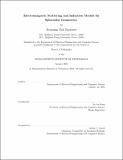| dc.contributor.advisor | Jin Au Kong. | en_US |
| dc.contributor.author | Barrowes, Benjamin E., 1973- | en_US |
| dc.contributor.other | Massachusetts Institute of Technology. Dept. of Electrical Engineering and Computer Science. | en_US |
| dc.date.accessioned | 2005-05-17T14:39:56Z | |
| dc.date.available | 2005-05-17T14:39:56Z | |
| dc.date.copyright | 2004 | en_US |
| dc.date.issued | 2004 | en_US |
| dc.identifier.uri | http://hdl.handle.net/1721.1/16611 | |
| dc.description | Thesis (Ph. D.)--Massachusetts Institute of Technology, Dept. of Electrical Engineering and Computer Science, 2004. | en_US |
| dc.description | Vita. | en_US |
| dc.description | Includes bibliographical references (p. 271-280). | en_US |
| dc.description | This electronic version was submitted by the student author. The certified thesis is available in the Institute Archives and Special Collections. | en_US |
| dc.description.abstract | Electromagnetic scattering from a medium containing randomly distributed discrete dielectric spheroidal inclusions is studied. Also, the broadband magnetoquasistatic solution for the induced magnetic field from a conducting and permeable spheroid under time harmonic excitation is demonstrated. Analytical electromagnetic solutions for spheroidal geometries are desirable because of their versatility in modeling manmade and natural shapes includ- ing solid and hollow needles, spheres, and disks, while at the same time possessing analytic solutions. Coherent scattering from a collection of small dielectric spheroids populating a dense medium is compared to scattering from a homogeneous sphere. A Method of Moments (MoM) solution is adopted which accounts for spheroid-spheroid interactions directly. Coherent scattering results from these collections are compared to Mie scattering and the effective permittivity of the dense medium is obtained. Results are in good agreement to the classical mixing formula and this lends credibility to both models. In order to reduce memory requirements and computational complexity, the Sparse Matrix/Canonical Grid (SMCG) method is applied to 3-D dense media scattering. By approximating the dyadic Green's function about a canonical rectilinear grid, weak interaction between spheroid far apart may be quickly approximated. Strong interactions between dielectric spheroid in close proximity are still calculated directly. Weak interactions are quickly evaluated using a novel multilevel block-Toeplitz matrix vector multiply based on the Fast Fourier Transform. | en_US |
| dc.description.abstract | (cont.) Electromagnetic induction (EMI) models of conducting and permeable spheroids under time harmonic excitation are refined to produce the broadband response with high dependability. A hybrid method is constructed consisting of three different approaches: 1) at low frequencies, the formally exact (but truncated) solution is applied, 2) at moderate frequencies, asymptotic expansions of the spheroidal wave functions (SWFs) are employed, 3) and at high, but still magnetoquasistatic, frequencies, a Small Penetration Approximation is borrowed. The combined EMI response is accurate except near a switchover point where there is typically less than a two percent error. Results are compared to data from a set of 17 steel and aluminum machined spheroids taken by the GEM-3 instrument and found to be in excellent agreement. Asymptotic expressions of the SWFs are found to depend on branch points and associated characteristic eigenvalues of the spheroidal wave equation. These branch points are found using polynomial estimation techniques and a quadruple precision Newton-Rhapson search method. Branch points for (n - m) =/< 100 are found in greater accuracy than previously available and many are tabulated in this thesis. The solution for the induced magnetic field from multiple permeable and conducting spheroidal objects in close proximity under time harmonic excitation is presented. Interactions between spheroids is accounted for by a interspheroidal modal interaction matrix. This multibody solution may provide the basis for a forward model used by inversion routines designed to detect and discriminate UXO. Specifically, this multibody solution may help to isolate non-UXO clutter from actual UXO in the field. | en_US |
| dc.description.statementofresponsibility | by Benjamin Earl Barrowes. | en_US |
| dc.format.extent | 281 p. | en_US |
| dc.format.extent | 14535092 bytes | |
| dc.format.extent | 14534681 bytes | |
| dc.format.mimetype | application/pdf | |
| dc.format.mimetype | application/pdf | |
| dc.language.iso | eng | en_US |
| dc.publisher | Massachusetts Institute of Technology | en_US |
| dc.rights | M.I.T. theses are protected by copyright. They may be viewed from this source for any purpose, but reproduction or distribution in any format is prohibited without written permission. See provided URL for inquiries about permission. | en_US |
| dc.rights.uri | http://dspace.mit.edu/handle/1721.1/7582 | |
| dc.subject | Electrical Engineering and Computer Science. | en_US |
| dc.title | Electromagnetic scattering and induction models for spheroidal geometries | en_US |
| dc.type | Thesis | en_US |
| dc.description.degree | Ph.D. | en_US |
| dc.contributor.department | Massachusetts Institute of Technology. Department of Electrical Engineering and Computer Science | |
| dc.identifier.oclc | 55667846 | en_US |
